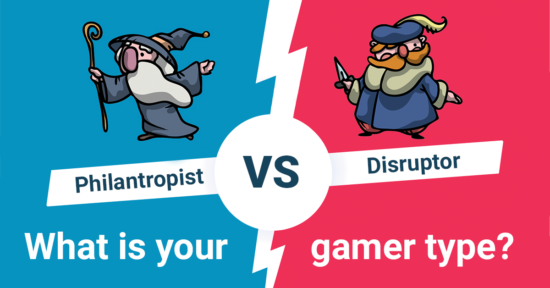How do companies categorize players and is it dangerous?
- 6 września, 2021
- Michał Dębek
Did you know that players can be categorized in many different ways? There are no two identical people in the world, and each player is different. We differ in dozens of ways – biologically, socially, and psychologically. It often turns out that, whether consciously or not, we belong to a certain group or type of people. Things are no different in the gaming culture. How are players categorized? What criteria are used? What is the point of the categories? What is all this for, and what do game developers and publishers gain by doing it? And finally, is it dangerous from the player’s perspective?
There are many ways to categorize („profile”) players. In this text, I will discuss the four main „philosophies” for categorizing players and deriving conclusions about them.
Player segmentation based on simple features and behaviors
The easiest way is to organize players into groups due to demographic characteristics and basic gaming behavior: how often they play, what their favorite genres are, what hardware they, how long their playing sessions are, and whether they prefer multiplayer or single-player games. It is a kind of consumer profiling based on very simple indicators, and it is quite effective. Profiling often consists in categorizing players into hardcore and casual gamers, but can also take on more complex structures. For example, in our Gaming Sense 2020 research, we identified three main player segments based on such data: Engaged, Moderately Engaged and Unengaged gamers, and among them a few additional subgroups, including:
- Engaged generous – players who play on consoles a little more often than on PC, read gaming media more than other groups, show the most interest in information about games. They play action games much more often than others and, as the name of the group indicates – spend the most on games.
- Engaged Frugal Finishers – players spending the most of their free time playing, less than other action games fans, but more survival horrors and simulators.
- Engaged Frugal Frequenters – strongly preferring core genres, i.e. fighting, hack’n’slash and MMORPG games. Their the self-assessment of knowledge about the gaming market was the highest of all the groups (closest to the so-called hardcore players).
This is just one of many possible ways to categorize gamers. Based on such groups, game developers and publishers can conduct further, more complex analyzes of players’ behavior and motivations in order to better understand them and, as a result, create games that better match their needs.
Bartle’s taxonomy of player types
You can categorize players by behavior, but this requires more detailed and less „rigid” indicators. For example, as in the popular typology proposed by Richard Bartle – players can be asked what kind of behavior they’d rather engage in games: ruthlessly killing enemies, using persuasion, engaging in combat or exploring new territories. What makes you more happy – just killing a monster or bragging about it in front of your friends, etc? Once you provide the answers to 30 such questions, you get classified as one of four types of players:
- Achiever
- Explorer
- Socializer
- Killer
(you can read more about these types here).
So what, you ask?
For example: when the game developer or publisher knows that its main audience is Explorers, they will focus on developing specific threads and mechanics supporting the discovery of the (open) world, on design more attractive collectibles, hidden locations with great loot, etc.
If, on the other hand, the game is expected to appeal to Killers, the developer must take into account that they are adrenaline and experience seekers who enjoy provoking chaos and drama;
This gamer group usually includes extreme PvP players, highly competitive players who take pleasure in watching other players fail.
This is essential information which allows you to better design the game and plan its marketing. First of all, knowing the types of players makes it easier to precisely meet their needs, which ultimately benefits creators, publishers, and players alike.
Game dynamics preferences and player types
You can categorize players by their preferences or dislikes for specific game mechanics, or rather „dynamics”. Game dynamics emerge from game mechanics when multiple game mechanics are triggered by continued player actions. These can be relatively simple: „Creating your own playable character” or „Fighting by using close combat skills and techniques”, or the more complex ones like „Managing groups, clans or cities and their residents”, or „Considering and coming up with a strategy and choosing resources for it” .
Thanks to our mapping of the dynamics of five main groups: assault, manage, journey, care, and coordinate, scientists from the University of Turku in Finland are able to classify players into one of the seven types:
- the Mercenary,
- the Companion,
- the Commander,
- the Adventurer,
- the Patterner,
- the Daredevil,
- the Explorer.
For example: it is known that:
if you prefer “assault” with a little “manage” and “journey” dynamics, but are not very fond of the “care” group, you will be classified as the Mercenary. We know what game will appeal to you.
On the other hand – if a game is rich in “assault” with an admixture of “journey” mechanics, the publisher should be targeting Mercenary players. A game that’s primarily journey-themed, (but not containing manage mechanics), should targeted at the Adventurer type players. If the game is intended for the Commanders, its manage dynamics must be polished to perfection. And so on.
Six motivations and types of gamers: Hexad framework
There is a completely different level, at which players are categorized based on the question: why do players play at all? In other words: what motivates them, what pushes them to play, what attracts them to certain games.
In such classifications, the basis is the general psychological knowledge of motivation, i.e. what motivates people (not only players) to act.
There are a lot of significant motives of human behavior in psychology. They range from social mimicry (the unconscious tendency to imitate the behavior of people similar to us) as well as the opposite – anti-conformism (the desire to avoid similarities to others), through the need for stimulation (the desire to experience something new, learn new things), the need to reduce negative emotions, strengthen positive emotions, etc., all the way to the pursuit of a sense of purpose, belonging, and autonomy or, in short: freedom.
At a higher level, the motives behind human behavior fall into two groups:
- internal (in the case of players, it is mainly curiosity, striving to learn the history and development of events, developing their competences and being better);
- external (playing for specific rewards such as ranking up, getting badges, achievements, and various quasi-material benefits such as in-game currency).
By analyzing and grouping the various motives which the players can follow, an international team of scientists has created a classification which can be used to classify each player in six dimensions:
- Philanthropists (motivated by purpose),
- Socialisers (motivated by relatedness),
- Free Spirits (motivated by autonomy),
- Achievers (motivated by competence),
- Players (motivated by extrinsic rewards),
- Disruptors (motivated by the triggering of change).
Each of us has a fraction of each of the above types of players. Players are rarely pure Disruptors or Achievers. Instead, each player is a mix of types with a few dominant types. Each of the dominants, in turn, requires certain key elements in games.
For example, if your dominant „inner” gamer type is Player, you are very likely enjoy collecting rewards, no matter what type of game. It is also known that, for a player like you, the developer will need to implement specific in-game elements such as: points, prizes, leaderboards, badges, achievements, an extensive virtual economy, and maybe even raffles. If, on the other hand, your dominant type is the Free Spirit, developers should prepare specific exploratory tasks, nonlinear gameplay, a lot of easter eggs, unlockable content, creativity tools, and various tools allowing you to customize the game.
What is all this for and is it dangerous for us players?
Research on the player motivations and how these motivations translate into the desired mechanics or dynamics is a very promising element of data-driven game development. Thanks to the results of precise and extensive research of this type,
game developers have the data to design even better games which more precisely respond to the actual needs of players.
Therefore, we encourage that you take part in our research projects – these projects are always aimed at improving games in production or modifying game ideas so that they appeal to the largest possible target audience. Games are created specially for specific players, which is why their voice is often decisive and affects the final shape of the production. We recently wrote about why it is worth taking part in this type of research and how important player feedback is for developers.
Surveys of player motivation and behavior are usually remote, and they allow the player to maintain complete anonymity (however, the player may be required to provide basic personal information such as name and e-mail so that he can be contacted regarding the prize).
Remember that game developers and publishers, as well as analytical companies such as Try Evidence do not associate data on gamer motivations, needs or behaviors with specific people. There is no need for that anymore.
Participation in such projects, and providing such information is in no way threatening and does not serve any „evil goals”. The only goal behind it is to better understand the needs of certain groups of players and use them to help developers and game publishers make important decisions about the games they’re developing. At the same time, we believe (and actually know from the feedback and comments we collect from our test players) that participation in the game development process is very satisfying, especially when the gamers see that the mechanics and solutions they suggested to the developers were actually implemented. You have a moment to spare and feel like doing it – please join one of our ongoing research projects, the list of which can be found below.
*
If you want to find out your player type according to the Hexad typology, we invite you to join one of our ongoing research projects here
You do not need to provide any personal data to get the result.
_
Would you like to quote the article? Do it properly:
Dębek, M., Zalewski, D. (2021, 09 05). How do companies categorize players and is it dangerous? Retrieved from https://tryevidence.com/pl/blog/w-co-graja-jak-graja-i-czego-oczekuja-polscy-gracze-polish-gaming-sense-2020.








